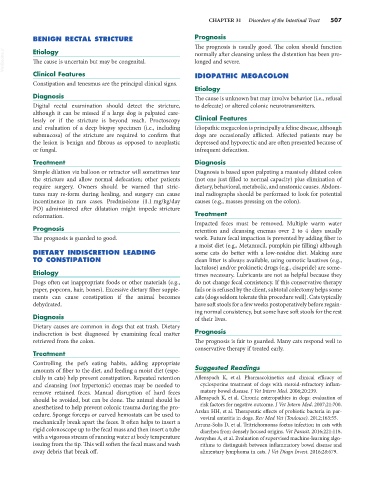Page 535 - Small Animal Internal Medicine, 6th Edition
P. 535
CHAPTER 31 Disorders of the Intestinal Tract 507
BENIGN RECTAL STRICTURE Prognosis
The prognosis is usually good. The colon should function
Etiology
VetBooks.ir The cause is uncertain but may be congenital. normally after cleansing unless the distention has been pro-
longed and severe.
Clinical Features IDIOPATHIC MEGACOLON
Constipation and tenesmus are the principal clinical signs.
Etiology
Diagnosis The cause is unknown but may involve behavior (i.e., refusal
Digital rectal examination should detect the stricture, to defecate) or altered colonic neurotransmitters.
although it can be missed if a large dog is palpated care-
lessly or if the stricture is beyond reach. Proctoscopy Clinical Features
and evaluation of a deep biopsy specimen (i.e., including Idiopathic megacolon is principally a feline disease, although
submucosa) of the stricture are required to confirm that dogs are occasionally afflicted. Affected patients may be
the lesion is benign and fibrous as opposed to neoplastic depressed and hyporectic and are often presented because of
or fungal. infrequent defecation.
Treatment Diagnosis
Simple dilation via balloon or retractor will sometimes tear Diagnosis is based upon palpating a massively dilated colon
the stricture and allow normal defecation; other patients (not one just filled to normal capacity) plus elimination of
require surgery. Owners should be warned that stric- dietary, behavioral, metabolic, and anatomic causes. Abdom-
tures may re-form during healing, and surgery can cause inal radiographs should be performed to look for potential
incontinence in rare cases. Prednisolone (1.1 mg/kg/day causes (e.g., masses pressing on the colon).
PO) administered after dilatation might impede stricture
reformation. Treatment
Impacted feces must be removed. Multiple warm water
Prognosis retention and cleansing enemas over 2 to 4 days usually
The prognosis is guarded to good. work. Future fecal impaction is prevented by adding fiber to
a moist diet (e.g., Metamucil, pumpkin pie filling) although
DIETARY INDISCRETION LEADING some cats do better with a low-residue diet. Making sure
TO CONSTIPATION clean litter is always available, using osmotic laxatives (e.g.,
lactulose) and/or prokinetic drugs (e.g., cisapride) are some-
Etiology times necessary. Lubricants are not as helpful because they
Dogs often eat inappropriate foods or other materials (e.g., do not change fecal consistency. If this conservative therapy
paper, popcorn, hair, bones). Excessive dietary fiber supple- fails or is refused by the client, subtotal colectomy helps some
ments can cause constipation if the animal becomes cats (dogs seldom tolerate this procedure well). Cats typically
dehydrated. have soft stools for a few weeks postoperatively before regain-
ing normal consistency, but some have soft stools for the rest
Diagnosis of their lives.
Dietary causes are common in dogs that eat trash. Dietary
indiscretion is best diagnosed by examining fecal matter Prognosis
retrieved from the colon. The prognosis is fair to guarded. Many cats respond well to
conservative therapy if treated early.
Treatment
Controlling the pet’s eating habits, adding appropriate
amounts of fiber to the diet, and feeding a moist diet (espe- Suggested Readings
cially in cats) help prevent constipation. Repeated retention Allenspach K, et al. Pharmacokinetics and clinical efficacy of
and cleansing (not hypertonic) enemas may be needed to cyclosporine treatment of dogs with steroid-refractory inflam-
remove retained feces. Manual disruption of hard feces matory bowel disease. J Vet Intern Med. 2006;20:239.
should be avoided, but can be done. The animal should be Allenspach K, et al. Chronic enteropathies in dogs: evaluation of
risk factors for negative outcome. J Vet Intern Med. 2007;21:700.
anesthetized to help prevent colonic trauma during the pro- Arslan HH, et al. Therapeutic effects of probiotic bacteria in par-
cedure. Sponge forceps or curved hemostats can be used to voviral enteritis in dogs. Rev Med Vet (Toulouse). 2012;163:55.
mechanically break apart the feces. It often helps to insert a Arranz-Solis D, et al. Tritrichomonas foetus infection in cats with
rigid colonoscope up to the fecal mass and then insert a tube diarrhea from densely housed origins. Vet Parasit. 2016;221:118.
with a vigorous stream of running water at body temperature Awayshes A, et al. Evaluation of supervised machine-learning algo-
issuing from the tip. This will soften the fecal mass and wash rithms to distinguish between inflammatory bowel disease and
away debris that break off. alimentary lymphoma in cats. J Vet Diagn Invest. 2016;28:679.

